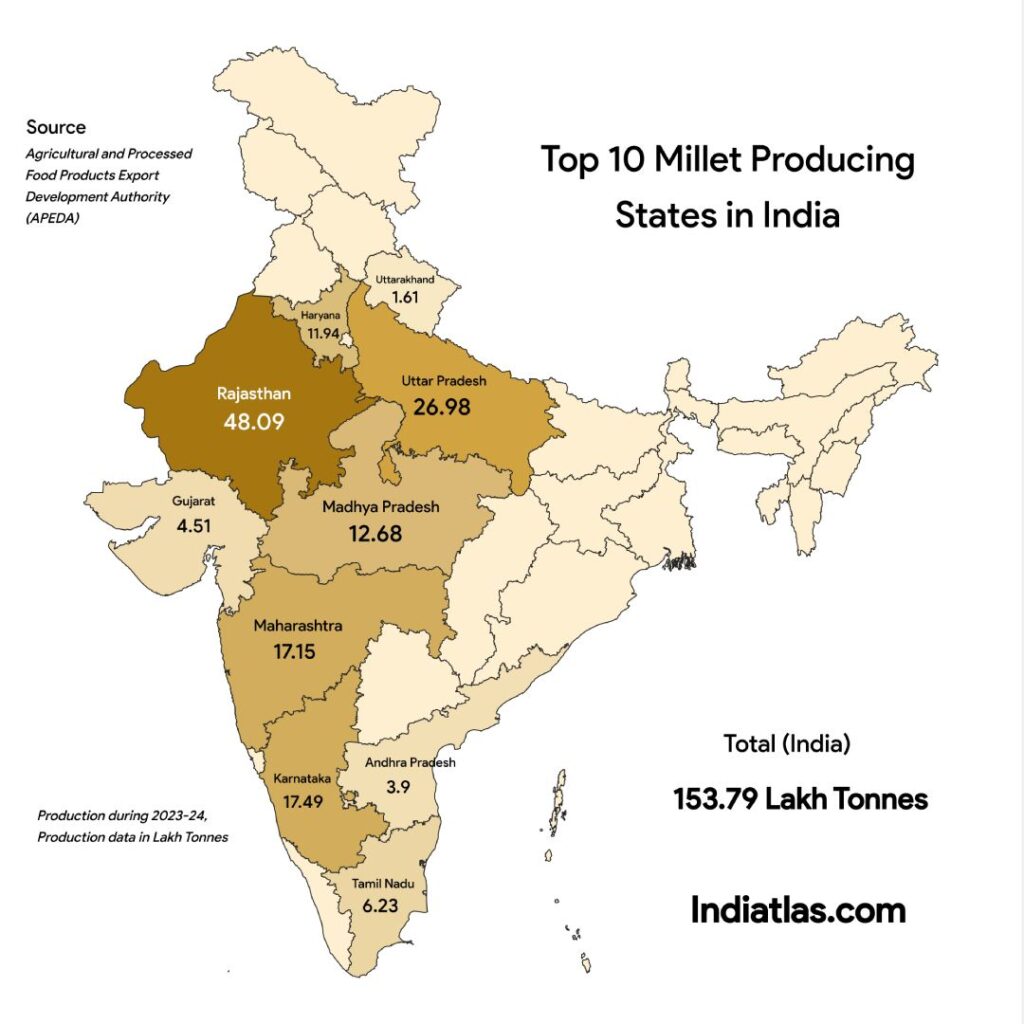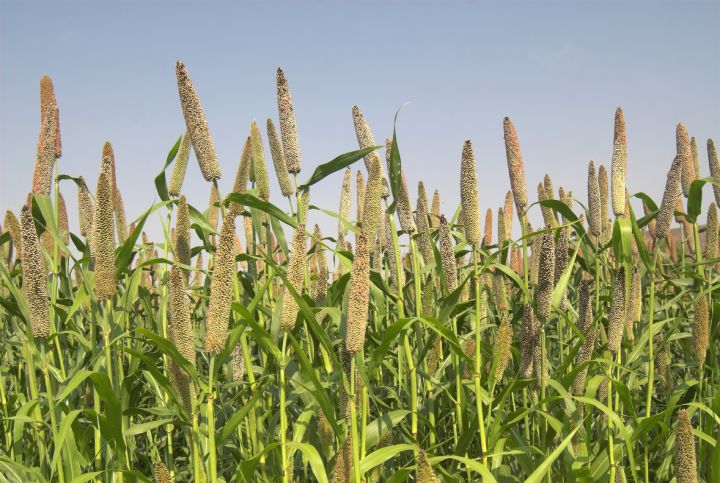As the demand for healthier food options rises, millets are making a strong comeback in India’s agriculture landscape. The Top 10 millet producing states in India are leading the way by raising awareness, showcasing innovative farming practices, and significantly boosting the country’s millet production.
From arid regions to fertile landscapes, these states cultivate a variety of millets adapted to their specific climates and land conditions, employing diverse agricultural methods.
These states play a critical role in contributing to India’s millet output, enhancing food security, and promoting nutritional diversity.
Many factors, including climate, soil quality, and agricultural practices, significantly impact millet production.
As India strives for self-sufficiency in food production, millet cultivation is gaining momentum.
Renowned for their drought resistance and impressive nutritional profiles, millets have become increasingly sought after. This is due to growing awareness and government initiatives aimed at promoting these ancient grains.
Let’s explore the Top 10 millet producing states in India, their agricultural practices, contributions to the millet sector, and the factors that make them leading producers of these vital grains.


1. Rajasthan: Highest Millets Producing state in India
Known for its arid landscapes and innovative agricultural practices, Rajasthan is the largest millet producing state in India, producing 48.09 Lakh tonnes of millets during 2023-24. Also, it stands top among the Bajra producing states in India.
Rajasthan solely accounts for 31.26% of national millet production.
The state’s arid climatic conditions, characterized by high temperatures, low rainfall and water scarcity, made millets a suitable crop in this state.
Millets do very well even in these harsh climatic conditions and are drought-resistant, making farmers choose millets rather than any other crop.
Among millets, Bajra or Pearl millet is highly cultivated in Rajasthan, followed by Sorghum or Jowar and small millets.
Barmer, Alwar, Jaipur, Jodhpur, Jalore, Sikar and Nagaur are some of the districts in Rajasthan renowned for millet production.
Farmers use traditional intercropping methods and several innovative farming practices in millets cultivation.
The state government also supports millet cultivation by providing training, free seed kits, and financial assistance to farmers.
Millets also hold great cultural significance in Rajasthan and are highly used in traditional cuisines and festivals.
2. Uttar Pradesh
The State of Uttar Pradesh stands second in the Top 10 millet producing states in India, with a production of 26.98 Lakh tonnes accounting for 17.54% of the nation’s share.
The arid and semi-arid climate in several regions of the state made millets the best choice for farmers to cultivate.
Uttar Pradesh produces different types of millets. However, pearl millet is highly cultivated, followed by sorghum, barnyard, and kodo millets.
In this state, Agra, Firozabad, Badaun, Aligrah, Ettah, and Kasganj Districts are the regions where the majority of millet cultivation happens.
The government has taken several steps and initiated programs like the Uttar Pradesh millets revival programme. This programme aims to promote the production, processing and consumption of millets.
To achieve the program goals, the government allocated 186.26 crores financial allocation to support the processing, packing and marketing of products made from millets, alongside the awareness campaigns and free seed distribution.
3. Karnataka
Standing third in the list, Karnataka state had produced 17.49 Lakh tonnes of millets, accounting for 11.37% of the nation’s share.
Karnataka plans to double its millet exports and is taking the necessary steps to achieve the goal. Promotional programmes and initiatives to increase millet production are being undertaken by the state’s Department of Agriculture.
Major millets cultivated in Karnataka include Sorghum and Finger millet (Ragi). Infact, Karnataka is the largest Ragi producing state in India.
Karnataka had exported 7764 tonnes of millets to countries like the United States, UAE, Canada, and Qatar.
Chitradurga, Ballari, Koppal, and Tumakuru districts are regarded for their millet production. The farmers there are known for their innovative practices in the cultivation of millets.
The requirement for less labour, tolerance to diseases, low input costs, and minimal usage of fertilizers have made millets a popular choice for cultivation by Karnataka farmers.
Ragi mudde, created from finger millets or ragi, serves as a staple food in many households and reflects the cultural significance of millets in Karnataka cuisine
4. Maharashtra
Standing very close to Karnataka in terms of production, Maharashtra stands fourth in the list with a production of 17.15 Lakh tonnes for 2023-24. This makes up 11.15% of the country’s millet output.
Sorghum (Jowar), Pearl millet (Bajra), and Finger millet (Ragi) are cultivated in Maharashtra.
An interesting fact is that Maharashtra stands first among the top 10 jowar producing states in India.
Solapur, Ahmednagar, Osmanabad, Satara, Jalna, and Beed regions in this state are noted for their Jowar production. Where as Nasik, Aurangabad, and Ahmednagar for Bajra.
State government had launched a programme called the Maharashtra millet mission with a financial allocation of 200 crores to spread awareness and increase the production of millets.
Due to the increasing demand for millets, several farmers in drought-prone regions of the state are choosing Bajra and Jowar over traditional crops.
Bajra has great significance in Maharastra and it is used to prepare bhakri, a type of flatbread staple in many rural communities.
5. Madhya Pradesh
Madhya Pradesh has a prominent place in India’s millet landscape and is known for its millet production.
This state produced 12.68 Lakh tonnes of millets during 2023-24, which makes up 8.24% of India’s millet production.
This state has a long millet production history and several semi-arid regions that suit millet cultivation.
Dindori and Mandla regions in this state are renowned for millet cultivation.
Small millets like Kodo and little millets (Kutki) are also highly cultivated in this state along with Jowar and Bajra.
Millets have been a staple diet of various tribals and rural communities in Madhya Pradesh.
State Government had also taken several steps to increase the Kodo or little millets cultivation and had even giving cash incentives for millets production.
6. Haryana
With a production of 11.94 (7.76% in national share) Lakh tonnes of Millets, Haryana stands sixth in the list of Top 10 Millet producing states in India.
Although farmers cultivate rice and wheat extensively in Haryana, millets have gained traction, especially in the state’s drought-prone regions.
Jowar and Bajra are the major millets grown in this state, with considerable amounts of small millets.
Mahendragarh, Bhivani, and Rewari regions are known for the Bajra cultivation.
The Haryana Government has taken several steps to promote and increase the production of millets through subsidies, training programs and financial assistance to farmers.
Also, farmers are adopting innovative practices and have shifted greatly towards organic millets farming.
This is fetching higher income to the farmers and promoting sustained agriculture practices.
7. Tamil Nadu
Renowned for its innovative Agricultural practices, Tamil Nadu has been known for its millet production since ancient times.
Many communities in Tamil Nadu consume millets as a staple diet.
Tamil Nadu had produced 6.23 Lakh tonnes of millets in 2023-24, which is 6.23% of the nation’s millet output.
Farmers in Tamil Nadu mainly cultivate Jowar, Bajra, Ragi (Finger millet), and Kodo millets among all millet types.
Villupuram, Cuddalore, Thoothukudi, and Tiruvannamalai districts in this state are the major contributors to Tamil Nadu millet output.
The State Government and NGOs are actively promoting millet cultivation and consumption through awareness, schemes and incentives.
Millet cultivation in this state often happens by intercropping pulses and legumes. Several institutions in Tamil Nadu are involved in research developing more pest-resistant and high-yielding millet varieties.
8. Gujarat
Gujarat, with a production of 4.51 Lakh tonnes of millets stands eighth in this list. This state accounts for 2.93% of total millets output in India.
Bajra tops the list of millets cultivated by farmers in Gujarat, with jowar, ragi, and other small millets coming next.
Banaskantha region in North Gujarat is renowned for Bajra cultivation, and most of Jowar comes from Surat, Narmada, and Tapi districts in South Gujarat.
This state has a rich history of millet cultivation and uses farming practices that include intercropping with millets.
The government proactively promoting millet cultivation through policies, subsidies and incentives.
9. Andhra Pradesh
With its rich agricultural heritage, fertile lands, and diverse climatic zones, Andhra Pradesh earned a great reputation in Agriculture.
This state stands ninth in the top 10 millet producing states in India, with a production of 3.9 Lakh tonnes of millets. This accounts for 2.53% of the nation’s share.
All types of millets are cultivated in Andhra Pradesh. However, Jowar, Bajra, and Ragi are cultivated highly with significant amounts of small millets.
Prakasam, Kurnool, Ananthapuram, Nandyala, YSR Kadapa, and Nellore are the districts in Andhra Pradesh where millets are highly cultivated.
Most of these districts are from the Rayalaseema and its surrounding regions which have semi-arid climates that have made farmers choose millets over other crops.
The State government is implementing several projects and has launched an AP millet mission for the revival of millet cultivation and promoting the consumption of millets and millet-made products.
Several NGOs and reformists had stepped in and spread a great awareness of millets as well as incorporating millet powder in several traditional dishes.
10. Uttarakhand
The State of Uttarakhand is fast emerging as an important contributor to millet production in India.
Uttarakhand produced 1.61 Lakh tonnes of millets in the year 2023-24, which accounts for 1.04% of India’s millet output.
In contrast to other states where jowar and bajra prevail, Uttarakhand’s agricultural landscape features high cultivation of finger millet, barnyard millet, and other small millets.
Almora, Tehri Garhwal, Pauri Garhwal, and Pithoragarh regions are known for Finger millet and small millets production.
The presence of diverse agroclimatic conditions allows the cultivation of multiple millet varieties that can thrive in different climates.
Millets were also a part of the local diet in several regions of this state. The government has launched several initiatives that aim to revitalize interest in millet farming and encourage sustainable agricultural practices.









